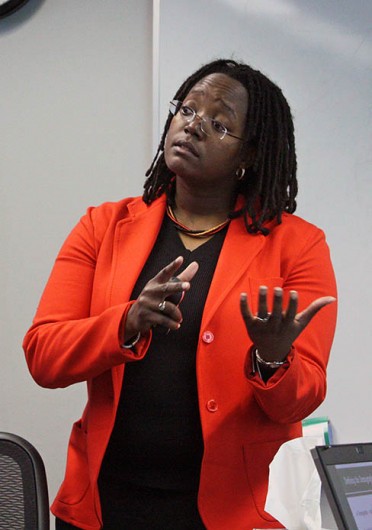
Evelyn Patterson, an assistant professor of sociology at Vanderbilt University, speaks at OSU March 6.
Credit: Logan Hickman / Lantern photographer
For individuals released after time in prison, one Vanderbilt University professor said there is no such thing as being completely free.
Evelyn Patterson, an assistant professor of sociology at Vanderbilt, visited Ohio State Thursday to present her research on prisoners and the effects of incarceration on freedom.
“You can only be free once. If you leave that state, there’s no going back,” Patterson said to the roughly 30 students and faculty members present during her lecture, titled “Questioning the Existence of Freedom.”
Free is one of the four “life-states” Patterson used to categorize people in her research. The other three are incarcerated, paroled and freed (formerly incarcerated or on parole, but now out of the correctional system).
“Most Americans only experience one state. They are born free and they live that way until they die,” Patterson said.
For those who are convicted and imprisoned, however, becoming truly free again is nearly impossible because of decreased job and educational opportunities, limitations on citizenship and the social stigma associated with incarceration. Patterson said those who are convicted are permanently “marked,” and her research shows a negative effect on their life expectancy and ability to work.
Patterson said there are about six times as many black males compared to white males who begin adulthood – turn 18 years old – incarcerated or on parole.
Once someone is marked, though, race does not matter as much, she said. The average proportion of working years spent incarcerated versus paroled or freed among those black and white men who begin adulthood incarcerated is almost identical. Patterson defined working years as the time between the ages of 18 and 65.
To put it another way, white convicts and black convicts at age 18 can expect to spend about the same proportion of their working years, 18 percent on average, in a prison or prisons.
Trent Steidley, a graduate student in sociology who attended the lecture, said he wasn’t expecting to hear those kinds of statistics.
“(The similarity between white and black convicts) really surprised me,” Steidley said. “It goes against most of what I’ve heard when people talk about race and jail.”
While any one individual’s experience depends on the timing and duration of a prison sentence, Patterson said the overall state of America’s corrections system should be questioned, or at least re-examined.
“Without integrating duration (of incarceration), we likely underestimate the consequences of America’s past, current, and enduring burden of punishment,” Patterson said.
During the Q-and-A portion of the lecture, Ruth Peterson, professor emeritus of sociology and former director of OSU’s Criminal Justice Research Center played the role of devil’s advocate by asking, “What is the effect of underestimating the consequences? Why does this matter?”
“It affects so many things … (for example) our political climate is affected by restricted voting rights and counting prisoners as residents of the county where the prison is,” answered Patterson, who explained that the population skew ends up affecting how government funds for community assistance are distributed.
Almost every state places some voting restrictions on felons, where voting rights can be taken away permanently or can only be restored to the individual after their incarceration, parole or probation. Currently, only Maine and Vermont are unrestricted, where convicted felons may vote by absentee ballot while in prison, according to a chart on felon voting laws from ProCon.org, a nonprofit organization.
In Ohio, an individual cannot vote while incarcerated but is permitted to vote after release.
Patterson said the most surprising thing she has discovered was how much incarceration affected mortality rates. According to a study of hers that was published by the American Journal of Public Health in 2013, each additional year in prison produced a 15.6 percent increase in the odds of death for parolees. But how does this translate into a more understandable figure?
“Every year in prison decreases your life expectancy by two years,” Patterson said.


